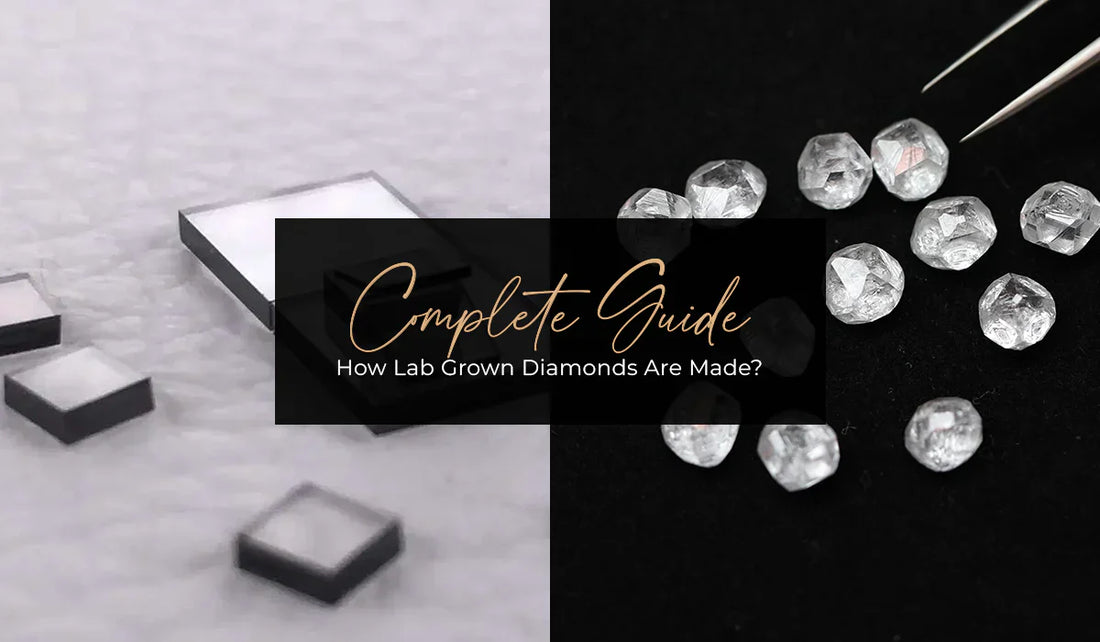
A Complete Guide on How Lab Grown Diamonds Are Made
Share
Diamonds have long been admired for their beauty and brilliance, but the methods used to obtain them have evolved. With concerns about the environmental impact of mining and the ethical dilemmas surrounding traditional diamond sourcing, lab-grown diamonds have emerged as a revolutionary alternative. What exactly are lab grown diamonds, and what is their creation process?
In simple terms, lab-grown diamonds are real diamonds, just created in a laboratory environment using advanced technology. These diamonds have the same chemical composition, clarity, and sparkle as natural diamonds formed beneath the Earth's surface but are made in a matter of weeks instead of billions of years.
In this post, we will dive deep into the fascinating process of how lab-grown diamonds are made, focusing on two main techniques: High Pressure High Temperature (HPHT) and Chemical Vapor Deposition (CVD). These methods allow scientists to replicate the natural diamond-forming process in a controlled setting, bringing to life these sparkling stones.
How Exactly Are Lab-Grown Diamonds Made?
The creation of lab-grown diamonds is a highly controlled and scientific process, replicating the natural formation of diamonds on the Earth. There are two main methods used to grow diamonds in labs: HPHT (High Pressure High Temperature) and CVD (Chemical Vapor Deposition). Both approaches use a small diamond seed and carbon to form the diamond, but they differ in their technique.
Let’s look at how each method operates.
High Pressure High Temperature (HPHT)

The HPHT method replicates the natural conditions found deep within the Earth where diamonds are formed. Billions of years ago, diamonds formed under extreme heat and pressure, about 150 kilometers below the Earth’s surface. This natural process has been replicated in laboratories using advanced technology, and the HPHT technique is one of the earliest methods developed to grow diamonds.
Here’s how the HPHT process works:
- Starting with a diamond seed: The process begins with a tiny diamond seed, which is placed inside a press.
- Applying pressure and heat: The press subjects the seed to intense pressure (around 1.5 million pounds per square inch) and extreme temperatures (over 1,400 degrees Celsius). This simulates the environment found deep within the Earth.
- Crystallization of carbon: A source of pure carbon, usually in the form of graphite, is introduced. Under extreme pressure and heat, the carbon atoms begin to bond to the diamond seed, layer by layer. Over time, these carbon atoms crystallize around the seed, forming a rough diamond.
- Finishing: Once the diamond has grown to the desired size, it is carefully extracted, cleaned, and then cut and polished just like a natural diamond. The result is a lab-grown diamond that looks identical to one found in nature.
HPHT diamonds are often larger and can be used to create more complex shapes. They are also favoured for producing diamonds with certain colours, such as yellow and blue, which occur due to slight variations in the process.
Chemical Vapor Deposition (CVD)

The CVD method is a more modern technique used to grow lab-grown diamonds, and it has become increasingly popular due to its precision and control. The CVD process differs from HPHT in that it does not rely on high pressure but instead focuses on creating a diamond in a vacuum environment using gases.
Here’s how the CVD process works:
- Starting with a diamond seed: Similar to the HPHT method, a tiny diamond seed is used to begin the process. This seed is placed in a vacuum chamber, which is devoid of any oxygen to prevent unwanted reactions.
- Introducing carbon-rich gases: The vacuum chamber is filled with carbon-rich gases, such as methane or hydrogen. These gases are essential because they supply the carbon atoms needed to grow diamonds.
- Breaking down the gases: The gases are heated to extremely high temperatures using microwave or plasma technology. At these temperatures, the gases break down into their atomic components, releasing carbon atoms.
- Building the diamond: The carbon atoms begin to bond to the diamond seed, creating layers of crystalized carbon. Over time, the seed grows into a rough diamond. The CVD process allows for precise control over the environment, resulting in diamonds with fewer inclusions and more uniform quality.
- Final steps: Once the diamond has reached the desired size, it is removed from the chamber and goes through the same cutting and polishing process as natural diamonds.
One of the key advantages of CVD diamonds is that they can be grown to specific sizes and shapes, making the process more customizable. CVD diamonds are often used in high-end jewellery due to their exceptional quality and clarity.
Wrapping up
In the world of jewellery, lab-grown diamonds have become a shining example of how technology and sustainability can work together. Both the HPHT and CVD methods result in diamonds that are identical to natural diamonds in every way—no matter it’s their brilliance, durability, or beauty. However, lab-grown diamonds offer additional advantages: they are more ethical, environmentally friendly, and affordable.
At Avira Diamonds, we take pride in offering a wide selection of high-quality lab-grown diamonds for every occasion. Regardless you’re searching for the perfect lab-grown diamond engagement ring, a custom piece, or a timeless classic, our collection offers stunning designs for women and men. Come check out the beauty of lab-grown diamonds with Avira Diamonds today and discover the future of luxury jewellery.
Related blogs:
Lab Grown vs. Natural Diamonds
